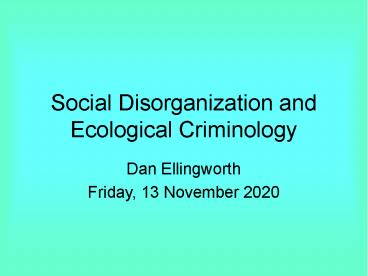Social Disorganization and Ecological Criminology - PowerPoint PPT Presentation
Title:
Social Disorganization and Ecological Criminology
Description:
Social Disorganization and Ecological Criminology Dan Ellingworth * Lecture Outline Durkheim and Anomie The Chicago School Robert Park Shaw and Mackay s ... – PowerPoint PPT presentation
Number of Views:296
Avg rating:3.0/5.0
Title: Social Disorganization and Ecological Criminology
1
Social Disorganization and Ecological Criminology
- Dan Ellingworth
- Friday, 13 November 2020
2
Lecture Outline
- Durkheim and Anomie
- The Chicago School
- Robert Park
- Shaw and Mackays Concentric Zones
- Social Disorganization
- Environmental Criminology
- Routine activities theory
- Crime Mapping
- Community crime careers
- Community Crime Prevention
3
Durkheim and Anomie
- Central concern how does society maintain
itself, whilst undergoing major social upheaval - Mechanical Solidarity ? Organic Solidarity
- Underdeveloped conscience collective resulting in
normlessness or Anomie - Crime and deviance results from a temporary lack
of norms and values
4
Social Disorganization Theory / Ecological /
Environmental Criminology
- Area crime / offending rates
- Influences of community characteristics on crime
- Land use and routine activities
- Importance of Informal Social Control
5
Chicago School
- Established 1892
- Aim to establish sociology as an organized,
empirical discipline - Robert Park anthropological and ecological study
of crime - Chicago an evolving city, characterised by waves
of immigration from Europe aim was to understand
this process
6
E.W. BurgessConcentric Circles
I - The Loop II- Zone of Transition III - Zone of
workingmens homes IV- Residential Zone V -
Commuters Zone
I
II
III
IV
V
7
Chicago School 1940s
- Shaw and Mackay social disorganisation
- juvenile delinquency residence rates, and other
social problems, concentrated in the zone of
transition - Patterns stable over time despite change
- Cultural heterogeneity constant turnover of
population inhibit maintenance of social order
8
Criticisms of Chicago School
- Crime the product of social organisation, not
disorganisation - Delinquency seen as the product and result of
disorganisation - Social disorganisation ignores differential power
levels, and the role of economic factors
9
Legacy of Chicago School
- Crime can be effected by the broader policies
shaping the urban city - Measures against crime should seek to socialise
and integrate (especially youth) - The geography of crime
- Most effective resource for crime prevention is
to be found in the ordinary members of the
population natural surveillance in communities
10
Crime Mapping
- Technologically driven GIS mapping
- Identification of offenders and offending
- Hotspot analysis a recognition that crime
incidents are clustered in small areas
11
Wilson and Kelling
- Broken Windows Thesis
Disorder
Fear of Crime
Informal control undermined
Potential increase in serious crime
12
Disorder and Fear of Crime
- Innovative focus on disorder and fear within
areas - Disorder Signals of a breakdown in the
realisation of conventional norms about public
behaviour, and a diminished capacity for problem
solving - Fear of Crime withdrawal from community, as well
as secondary victimisation
13
Spiral of decline
- Evidence that the pattern of decline is most
marked in working class communities where
residents are more sensitive to such barometers
of decline - Tipping points communities gain reputations
for tolerance of social disorder - Psychological / behavioural consequences
fatalism and mutual distrust
14
Defensible Space Oscar Newman
- Territoriality zones of influence
- Surveillance design buildings to allow easy
observation of areas - Image design buildings to avoid stigma in
low-cost / public housing - Environment the juxtaposition of public housing
with safe zones - a neglect of social factors?
15
Routine Activities Approach
- Marcus Felson
- A crime event occurs when 3 things coincide in
time and space - a motivated offender
- a suitable victim / target
- the absence of capable guardianship
- Social Disorder can inhibit capable guardianship
16
Primary Crime Prevention
- Primary Crime Prevention
- reduction of crime without reference to criminals
and potential criminals - leading role played by the police
- A.K.A. Situational crime prevention
- Increasing the effort required for crime
- Increasing the risks of detection
- Reducing the reward of crime
17
Secure by Design
See and Be Seen Bus Shelters
Big Issue Offices, Manchester
Royds Community Association, Bradford
18
Social Capital
- Individuals have resources associated with
inter-connections Social Capital - Communities benefit when social capital is high
- Collective efficacy the ability of groups to
respond and resist - Putnam social capital is in decline
- Communitarians (eg. Amitai Etzioni) a need to
reinvigorate the social / community in the face
of unfettered individualism
19
Summary
- Ecological approach of Chicago School looked at
social disorganization (akin to Durkheims
anomie) - Functionalist both theories saw
- norms / values / culture / ecology
- as the key to social order
- Contemporary approaches have borrowed this, and
applied it to a community based approach to
offending and crime prevention































